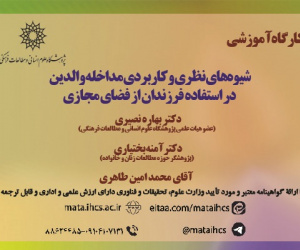فراشعر پست مدرن در شعر دهه هفتاد
آرشیو
چکیده
فراشعر پست مدرن مشرقی ژانری ست که برای اولین بار در ایران با کتاب جنس سوم (1384) مقوله بندی و تئوریزه شد. نمونه های ارائه شده اغلب دارای ویژگی های پست مدرنیستی مانند پلی فونی، بازی زبانی، آغازهای ناگهانی و پایآنهای باز، بازی با دستور زبان در زاویه عمودنگرانه یعنی حرکتی فرارونده برای گذر از هر گونه سیستم محوری در شعر است. فراشعر پست مدرن با الهام از چگونگی نگارش فراداستان پست مدرن که مرز بین داستان و تحلیل داستان (نقد) را برداشته بود با تعمیم این فضا به هنر شعر، توسط آذرپیک ارائه شد. در این شیوه چگونگی سرایش شعر و به کارگیری امکانات و تکنیک های شعری برای خوانشگر فاش می شود که بر اساس فاصله گذاری برشتی، خودآگاهانه سرایش شعر به گونه ای اتفاق می افتد که مخاطب در چگونگی آفرینش آن مشارکت یافته و از چند و چون آن آگاه می شود. این نوشتار به روش توصیفی تحلیلی و با استفاده از منابع کتابخانه ای صورت گرفته درصدد است تا تعریفی از فراشعر پست مدرن ارائه دهد و به معرفی فراشعر پست مدرن مشرقی بپردازد. در این راستا مشخص شد که در ایران تا پیش از مکتب اصالت کلمه تعریف مشخصی از فراشعر پست مدرن و ویژگی های آن ارائه نشده، از این رو ترجمه چند مقاله در مورد فراشعر و ارائه قسمت هایی از آن در این نوشتار راه گشا بوده است.Postmodern metapoetry in the poetry of the seventies
Postmodern oriental poetry is a genre that was categorized and theorized for the first time in Iran with the book Jens Som (1384). Examples presented often have postmodern features such as; Polyphony, linguistic play, sudden beginnings and open endings, playing with language grammar in a vertical angle means a evasive movement to pass through any system-oriented in poetry. Postmodern meta-poetry, inspired by how post-modern meta-fiction was written, which removed the border between fiction and story analysis (criticism), by generalizing this space to the art of poetry, was presented by Arash Azarpik in Kermanshah poetry workshops. In this way, how to write poetry and use the possibilities and Poetic techniques are revealed to the reader. Based on Brechtian spacing, the writing of poetry happens consciously in such a way that the audience participates in how it is created and becomes aware of its quantity and quality. This article tries to provide a definition of postmodern metapoetry and to introduce postmodern oriental metapoetry. In this regard, it was found that in Iran, a specific definition of postmodern hyperpoetry and its characteristics had not been provided before the school of originality of the word, therefore, translating several articles about hyperpoetry and presenting parts of it in this article has been a way forward.











